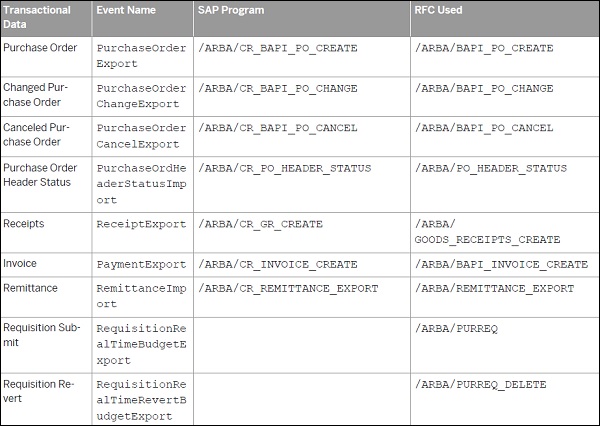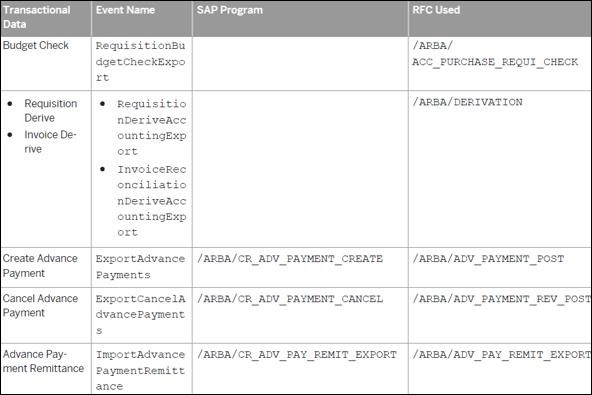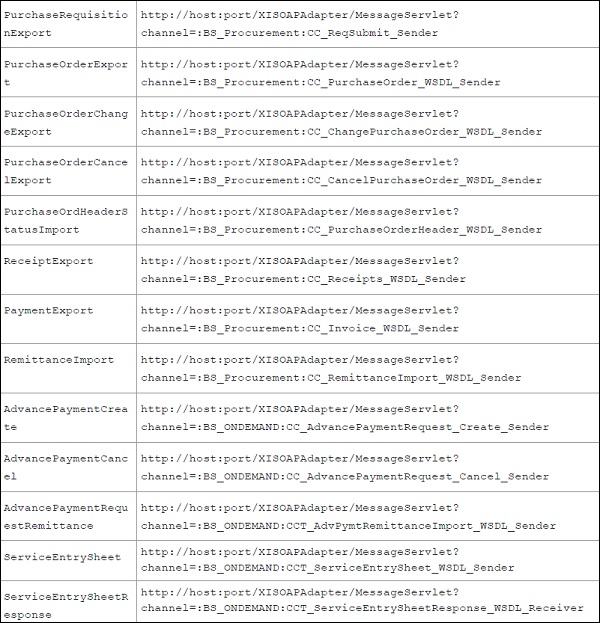SAP Ariba - Integration Transaction Data تكامل بيانات المعاملات ساب أريبا
تتضمن بيانات المعاملات طلب الشراء والفاتورة والإيصالات والمدفوعات والمعلومات التجارية الأخرى ذات الصلة. تأتي بيانات المعاملات مع طابع زمني وقيمة رقمية تشير إلى كائن واحد أو أكثر.
تُستخدم الطرق التالية بشكل شائع لدمج بيانات المعاملات بين SAP ERP وحل مشتريات Ariba -
استخدام خيار قناة الملف
استخدام قناة خدمات الويب
استخدام خيار واجهة المستخدم
استخدام تكامل الاتصال الوسيط
التكامل باستخدام خيار قناة الملف
لكل قناة ملف ، لديك أحداث تكامل مجدولة. يمكن لمسؤول Ariba تشغيل هذه الأحداث يدويًا. يتم تحديد رمز البرنامج القابل للتنفيذ وجدولته للتشغيل. يختار الكود ملف بيانات csv من حل مشتريات Ariba ويقوم بالتصدير إلى قاعدة بيانات SAP ERP.
يتم إنشاء ملفات CSV باستخدام أحداث المعاملة ويتم انتقاؤها بواسطة أداة نقل البيانات. لنقل البيانات إلى قاعدة بيانات ERP ، يجب استيراد عمليات نقل SAP. عمليات نقل SAP عبارة عن مجموعة من برامج SAP و RFCs والهياكل الداعمة. تُستخدم برامج SAP القابلة للتنفيذ لنقل البيانات المصدرة إلى SAP ERP. تساعد برامج BAPI القابلة للتنفيذ في نقل البيانات إلى SAP ERP.
تحتوي برامج SAP عادةً على المعلمات التالية -
اسم الملف المنطقي - يحدد هذا المسار المنطقي والموقع الفعلي لملفات CSV.
فاصل الدليل - هذا هو الفاصل المادي للدلائل في SAP ERP.
التشفير في ملفات الاستجابة - تقنية التشفير المستخدمة بشكل افتراضي UTF-8.
متغير - اسم متغير
القسم - اسم القسم
توضح الجداول التالية مكونات حدث تكامل بيانات المعاملات المختلفة -


استخدام قناة خدمات الويب
تعتمد طريقة خدمة الويب على استخدام عناوين URL لـ SOAP التي تم تكوينها بواسطة مسؤولي Ariba. لجميع الأحداث الصادرة ، يتم إنشاء عنوان URL لـ SOAP تلقائيًا ليكون موجودًا في WSDL المُنشأ وفقًا للمنطق التالي -
<IncomingHttpServerURL> / <ContextRoot> / soap / <realm name> / <event_name>
في كل WSDL ، لديك المكونات التالية -
استيراد - يستخدم هذا المكون لربط مساحة اسم بموقع المستند.
الأنواع - يُستخدم هذا المكون لتحديد أنواع البيانات التي أنشأها المستخدم ، والتي سيتم استخدامها في المستند.
الرسالة - يستخدم هذا المكون لتعريف جميع أجزاء الرسالة الفردية.
PortType - هذه حاوية للعمليات المدعومة بواسطة خدمة الويب. يتم ترتيب العمليات في PortType. تشير هذه العمليات إلى ما إذا كانت الرسالة واردة أو صادرة.
الربط - يعرّف هذا العنصر عملية تعيين البروتوكول. (على سبيل المثال ، http ، https ، MIME ، إلخ.).
الخدمة - يستخدم هذا المكون لتحديد العملية لتعيين العنوان ويظهر العنوان الفعلي الذي يجب إعادة توجيه الطلب إليه.
هناك العديد من أحداث تكامل بيانات المعاملات المنتشرة عبر حلول SAP ERP و Ariba Procurement.
يعرض الجدول التالي أمثلة على عناوين URL لكل حدث من أحداث تكامل البيانات -

استخدام خيار واجهة المستخدم
في Ariba Procurement Solution ، يمكن للمشترين أيضًا استخدام خيار الاتصال المباشر لدمج البيانات في نظام SAP ERP. هذه الميزة مدعومة في SAP ERP 6.0 والإصدارات الأحدث. باستخدام هذا الخيار ، يرسل نظام ERP طلبًا إلى Ariba Procurement Solution مع جزء الرأس الذي يحتوي على تفاصيل المعلمة لاستخراج بيانات المعاملات.
لاستخدام هذا الخيار ، يجب تنزيل طلب النقل واستيراده إلى نظام SAP ERP.

عند استخدام خيار الاتصال المباشر باستخدام واجهة المستخدم ، يتم تطبيق القيود التالية -
لا يوجد إشعار بالبريد الإلكتروني أثناء حدوث خطأ أثناء تكامل بيانات المعاملات.
يمكن لمسؤول Ariba رؤية جميع رسائل الخطأ فقط في شاشة وقت التشغيل لتكامل SAP ERP و SAP Process.
عندما تتحقق من T-code SLGI ، فإنه لا يخزن تفاصيل جميع سجلات الأخطاء في هذه المعاملة.
استخدام تكامل الاتصال الوسيط
تستخدم هذه الطريقة طبقة SAP Process Integration مع خيار الاتصال الوسيط لتكامل بيانات المعاملات. يوفر استخدام SAP PI طريقة آمنة للتكامل ويتم إنشاء جميع الشهادات ومخازن المفاتيح وتخزينها في مخزن مفاتيح SAP Process Integration.
لاستخدام هذا الخيار ، يجب تنزيل طلب النقل واستيراده إلى نظام SAP ERP. عند استخدام خيار الاتصال المباشر باستخدام واجهة المستخدم ، يتم تطبيق القيود التالية -
لا يوجد إشعار بالبريد الإلكتروني أثناء حدوث خطأ أثناء تكامل بيانات المعاملات.
يمكن رؤية جميع رسائل الخطأ فقط في شاشة وقت التشغيل لتكامل SAP ERP و SAP Process بواسطة مسؤول Ariba.
عندما تتحقق من T-code SLGI ، فإنه لا يخزن تفاصيل جميع سجلات الأخطاء في هذه المعاملة.
Transactional data includes Purchase Order, invoice, receipts, payments and other business related information. Transactional data comes with a time stamp and a numerical value referring to one or more objects.
Following methods are commonly used for integrating transactional data between SAP ERP and Ariba Procurement solution −
Using file channel option
Using the web services channel
Using user interface option
Using mediated connectivity integration
Integration Using File Channel Option
For each file channel, you have scheduled integration events. An Ariba administrator can run these events manually. An executable program code is defined and scheduled to run. The code picks csv data file from Ariba Procurement solution and exports to SAP ERP database.
CSV files are generated using transaction events and these are picked by data transfer tool. To move data to ERP database, SAP transports should be imported. SAP transports are a combination of SAP Programs, RFCs, and supporting structures. The SAP executable programs are used to move the exported data into SAP ERP. The BAPI executable programs help in the moving of data into SAP ERP.
SAP programs usually contain the following parameters −
Logical File Name − This defines the logical path and the physical location of the CSV files.
Directory Separator − This is the physical separator for directories in SAP ERP.
Encoding in response files − Encoding technique that is used UTF-8 by default.
Variant − Variant Name
Partition − Partition Name
The following tables show different transactional data integration event components −


Using the Web Services Channel
The Web service method is based on the use of SOAP URLs configured by Ariba administrators. For all outbound events, a SOAP URL is generated automatically to be present in the generated WSDL according to the following logic −
<IncomingHttpServerURL> / <ContextRoot> / soap / <realm name> / <event_name>
In each WSDL, you have the following components −
Import − This component is used to associate a namespace with a document location.
Types − This component is used to define user created data types, which will be used in the document.
Message − This component is used to define all the parts of an individual message.
PortType − This is a container of supported operations by the web service. The operations in PortType are ordered. These operations indicate whether a message is inbound or outbound.
Binding − This element defines the operation to protocol mapping. (for example, http, https, MIME, etc.).
Service − This component is used to define the operation to address mapping and it shows the actual address the request should be forwarded.
There are various transactional data integration events spread across SAP ERP and Ariba Procurement solution.
The following table shows example URLs for each data integration event −

Using User Interface Option
In Ariba Procurement Solution, buyers can also use direct connectivity option to integrate data to SAP ERP system. This feature is supported in SAP ERP 6.0 and later versions. Using this option, ERP system sends a request to Ariba Procurement Solution with the header part containing parameter details for extraction of transactional data.
To use this option, transport request must be downloaded and imported into SAP ERP system.

When you use direct connection option using user interface, following limitations are applied −
No email notification while an error occurs during the transactional data integration.
Ariba administrator can see all error messages only in the runtime monitor of the SAP ERP and SAP Process integration.
When you check T-code SLGI, it does not store details of all error log in this transaction.
Using Mediated Connectivity Integration
This method uses SAP Process Integration layer with mediated connectivity option for integration of transactional data. Using SAP PI provides a secure way of integration and all certificates and key stores are created and stored in SAP Process Integration key store.
To use this option, transport request must be downloaded and imported into SAP ERP system. When you use direct connection option using user interface, following limitations are applied −
No email notification while an error occurs during the transactional data integration.
All error messages can be seen only in the runtime monitor of the SAP ERP and SAP Process integration by Ariba administrator.
When you check T-code SLGI, it does not store detail of all error log in this transaction.
